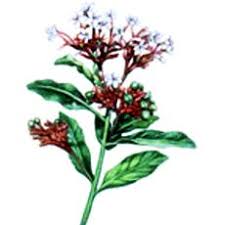
Scientific Name: Rauvolfia serpentina
Higher Classification: Rauvolfia
Family Name: Apocynaceae
Rank Name: Species
Order Name: Gentianales
Kingdom: Plantae
Genus: Rauvolfia
Species: R. serpentina
Division: Tracheophyta (Tracheophytes or Vascular Plants)
Sarpagandha
Published Date: 6/17/2023 5:59:10 AM
What is Sarpagandha:
- "Sarpagandha", also known as Indian Snakeroot in English, is a famous ayurvedic herb used for treating mild high blood pressure, nervousness, and mental disorders such as schizophrenia. It is also used for relief from snake and reptile bites, removing toxins, reducing anxiety, and insomnia (sleeplessness).
- It is an evergreen, erect glabrous perennial shrub that is native to the Indian subcontinent and East Asia. It grows in the lower Himalayas, the eastern and western ghats (two mountain ranges forming the eastern and western edges of India, More Details), and the Andaman Islands. In India, it is found in moist deciduous forest and shady areas at a height of 4000 feet above sea level.
- "Sarpagandha" is a Sanskrit word that literally means one which smells like a serpent. It comprises more than 50 different alkaloids out of which Reserpine is the most useful alkaloid in this plant. (More Details)
Availability:
- Its roots and leaves are used. "Sarpagandha" is available in powder (roots) and juice (leaves) form.
- "Sarpagandha" is a critically endangered species due to overexploitation. A team of researchers has found an alternative called Rauvolfia tetraphylla. (More Details)
What are its benefits:
- Reduces blood pressure (Hypertension): "Sarpagandha" reduces high blood pressure and provides support by calming the mind and reducing the hyperexcitability of the nervous system and maintain the right balance of myocardial oxygen.
- Insomnia (Sleeplessness): "Sarpagandha" helps induce sleep. Its root powder can be used for this purpose along with Rose Distillate ("Gulab Arq") 2 hours before sleep.
- Reducing fever: "Sarpagandha" is best for reducing high-grade fever. Sarpagandha Powder is used in a dosage of 500 mg thrice daily along with coconut water or Rose Distillate ("Gulab Arq").
- Dysmenorrhea (Painful Periods): "Sarpagandha" reduces pains occurring during the menstrual periods. It modulates the blood flow during menstruation and reduces cramps and throbbing pain. When used as a mixture of ginger and black pepper, it regularizes menstruation.
- Snake Bite: Mix "Sarpagandha" powder (10 gms), Black Pepper (3 gms), 1 Liter Water, and boil the water reducing it to 500 ml liquid. Take on regular intervals and finish within 24 hours. After finishing, take 500 mg Sarpagandha powder with honey thrice daily for 5 to 10 days for complete relief from snake poison.
- Treats skin diseases: It flushes out toxins from the body and also helps in blood purification. It also has been used in the treatment of intractable skin disorders like psoriasis, excessive sweating, and itching.
- Juice of leaves applied on the eye as a remedy for corneal opacity.
Ayurvedic Properties:
- Sarpagandha has the property to balance "Vata" dosha and "Kapha" dosha in the body.
- Rasa (Taste) is Tikta (Bitter). Guna (Main Quality) is Ruksha (Dry).
- "Vranahara" - It is useful to heal wound quickly.
- "Krumihara" - It is useful to relieve worm infestation and infection. detoxifies the poison of snakes, spiders, Scorpios, and mouse.
- "Virya" (Potency) is "Ushna" (Hot). "Vipaka" (Resultant) is "Katu" (Pungent) taste after digestion.
- "Vishamajwara" - It is useful in recurrent and chronic fever.
- Sarpagandha's "Prabhava" (Action) is a hypnotic that helps to induce sleep, In sleeplessness (Insomnia), it provides calmness to the brain and pacifies the vitiated for "Vata" dosha in the body. It helps various neurological conditions like stress, anxiety, depression, etc.
- It's "dhatu" (Tissue) effect is "Rasa" & "Rakta". It suppresses early ejaculation. Hence used in the treatment of premature ejaculation and early excitement.
Regional Names :
- English : Rauvolfia Root, Indian snakeroot, Serpentine Root, Serpentina Root, Hindi : chota chand, Dhaval barua, Nayi, Nakulikand, Nkulkanda, Dhavalbarua, chotachand, Rasna, Rarnabheda, Herkai chandra, Candrabhaga, Oriya : Dhanbarua, Sanochado, Gujrati : Amelpodee, Bengali : Chaandar, Chhoto Chadar, Chhoto Chand, Chandra, Sarpagandha, akuli, Sugandhanakuli, gandrasana, chandra Nolbel, amepadi, Telugu : Sarpagandhi, Patalagandhi, Kannada : Sutranaabhu, Sutranbhi, Malayalam : Amalpori, Marathi : Adkai, Chandra, Tamil : Sarppaganti, Chivan amelpodi, Carpakanta, Covanna Milpadi, sivan amalpodi, savannamibori, covanna milpori, Mandi : Do-grek-mi, Khumi : Mahaga, Urdu : Asrel, Trade name : Rauwolfia, Sarpagandha, Bihari : Dhanmarua, Chandmarua, Isargaj, Dhanbarua, Dhavalbarua, Sanachando, Burmese : Bongmaiza.